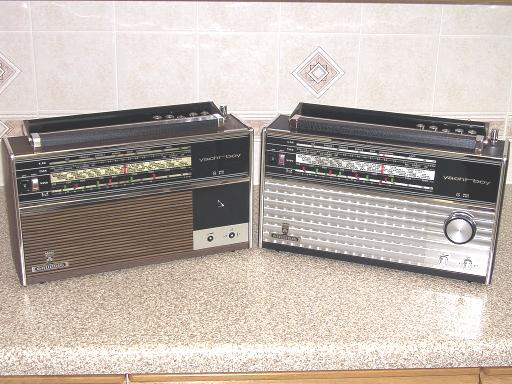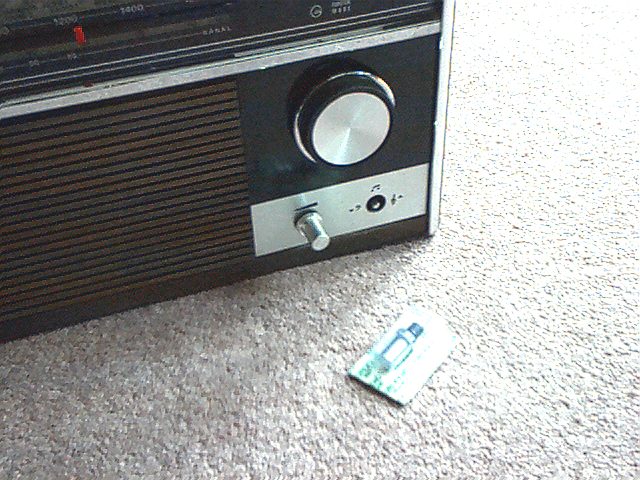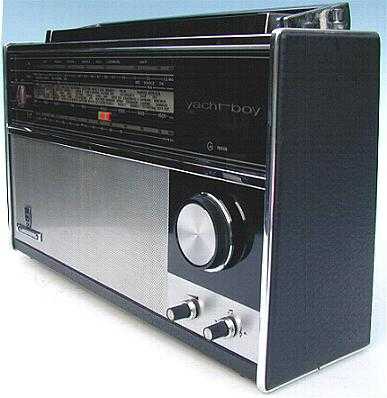 Radio
Boy
Radio
Boy
Yacht Boy 210 - 1970-1974
 Click on picture
for view of top of Yacht Boy 210.
Click on picture
for view of top of Yacht Boy 210.
This
is the actual radio which introduced me to Grundig, as described in the
"Grundig & I" page. Although it still worked
after all these years, FM had not worked for some time, and it was also
missing the tone control knob, as the spindle grip had broken many years
back while in my father's possession, and the knob had since disappeared.
(It has since been found again, slightly damaged where it mounts on the
shaft, but not unrecoverable).
However, in July
2004, a friend whose acquaintance I made through this website said he knew
someone who could repair it. So, it was safely packed and posted to Lee
Tucker, who took it to Leo Lyndon, a radio repair man of many years experience.
Within a week, the radio was fully functional again, properly realigned
with the help of the circuit diagram and the loan of Lee's black and silver
YB210, and made the return trip to my house. It was with great sadness
that I heard of Leo's death in late 2006. A man of many talents, and hidden
resources (see below) I'm sure he will be missed by many, not least his
son and other family members, as well as Lee and all who knew him.
Quite apart from
the personal loss to those around him, the loss of people like Leo means
that the knowledge and experience gained over years is gone in a moment.
It really seems so tragic. As a tribute to him, I will leave these pictures
here, showing him and his work. Apparently, it gave him quite a thrill
to know that he was featured on "The net" and it seems fitting to keep
his contribution here, so his family and friends can be sure that his presence
was appreciated by others.
Here is Leo with
the repaired radio in July 2004:
 Here are the 2 Yacht
Boys together, Lee's on the right:
Here are the 2 Yacht
Boys together, Lee's on the right:
 The knobs are missing
off my set as it was ready for posting back to me.
But that wasn't all,
Leo had also "found" a new tone control knob for my radio, completely as
new in the official Grundig spares packaging. Where he'd got this from
boggles the mind, but now you know what I mean by "hidden resources":
The knobs are missing
off my set as it was ready for posting back to me.
But that wasn't all,
Leo had also "found" a new tone control knob for my radio, completely as
new in the official Grundig spares packaging. Where he'd got this from
boggles the mind, but now you know what I mean by "hidden resources":
 And so, the radio
now performs and looks almost as new, still sounds great, has FM sensitivity
to compare well with any radio in it's class, and FM sound that has few
equals, it always amazed me how superb this radio sounded on FM, with crisp
treble that seems out of context given the lack of a tweeter, having just
one 7 x 4.5 inch speaker. Nevertheless, sound great it does, and I'm glad
to report that my memory of how well it sounded on FM wasn't flattered
by the mists of time, it IS as good as I remember. It is now complete,
with the optional TN12 mains unit fitted inside. The final good thing to
happen was that my mother, while looking for a piece of jewelry, found
the original tone control knob, mere weeks after I got this new replacement.
As I said, it's broken, but in an emergency, it would be able to be repaired
and used again. It is now stored inside the radio, so I'll know where to
find it if I ever need it!
View of rear access
panel open to access sockets, sliding the panel the other way reveals the
mains cable stowage area for the optional TN12 unit, and a small cutout
visible below the slide cover allows the cable to exit while the panel
is closed or open for the sockets:
And so, the radio
now performs and looks almost as new, still sounds great, has FM sensitivity
to compare well with any radio in it's class, and FM sound that has few
equals, it always amazed me how superb this radio sounded on FM, with crisp
treble that seems out of context given the lack of a tweeter, having just
one 7 x 4.5 inch speaker. Nevertheless, sound great it does, and I'm glad
to report that my memory of how well it sounded on FM wasn't flattered
by the mists of time, it IS as good as I remember. It is now complete,
with the optional TN12 mains unit fitted inside. The final good thing to
happen was that my mother, while looking for a piece of jewelry, found
the original tone control knob, mere weeks after I got this new replacement.
As I said, it's broken, but in an emergency, it would be able to be repaired
and used again. It is now stored inside the radio, so I'll know where to
find it if I ever need it!
View of rear access
panel open to access sockets, sliding the panel the other way reveals the
mains cable stowage area for the optional TN12 unit, and a small cutout
visible below the slide cover allows the cable to exit while the panel
is closed or open for the sockets:

Specification:
Styling:
Typical late 60's Grundig,
having much in common with Satellit's of the same era, especially about
the top. Actually came on the market in late 1969, and stayed for 4 years,
showing how popular it was. Late versions, model 210N, had mains unit installed
in factory. Mine is the wood finish, which although it is fake, is very
effective. Two silver & black versions existed. One had all silver
trim below the tuning scale, as pictured above, and the other had a black
panel around the tuning knob, & is pictured here for comparison:

Country of manufacture: Portugal.
Size: 242 mm high x 395
mm wide x 120 mm deep.
Weight (including batteries):
4.4kg.
Power supply:
Internal; 6 x D cells,
9V.
External; 9V DC. Space
inside set for TN4/TN5/TN12 mains unit and power cord. Switch to select
internal mains unit.
Consumption: 10W Max
Battery meter: Yes
Tuning method: Analogue.
Wavebands:
FM: 87.5-108 mHz,
LW 150-260 kHz, mode: AM
MW 510-1620 kHz, mode:
AM
SW 5850-7410 kHz, mode:
AM
Tuning meter: No
Local/DX switch: No
Aerials: Ferrite rod for
LW & MW, Telescopic for FM & SW
Dial illumination: Yes,
Internal power: Push
& hold to illuminate.
External power: Permanently
lit.
Mono selector: N/A, no stereo
facility.
Sockets:
Inputs;
9V DC
FM dipole
SW aerial
Aerial ground wire
DIN line-in
Outputs;
DIN line-out
External speaker or earphone
Output power: 2W RMS
Speaker: 7x4.5 inch elliptical.
Tone control: Variable
treble. Bass switch.
Clock/Timer: No







